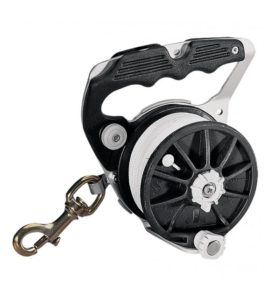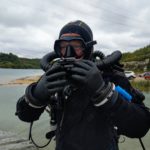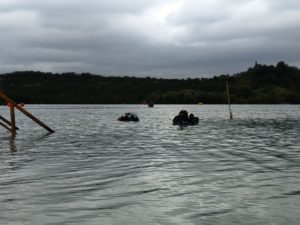 Everyone knows what a reel is. I assume, most of you know what a spool is. But what do we use these devices for when diving? Is it worth having?
Everyone knows what a reel is. I assume, most of you know what a spool is. But what do we use these devices for when diving? Is it worth having?
Let’s start at the end. During ordinary recreational dives, especially those in warm and clear waters, the idea of having a reel or even a spool (see the picture beside) seems to be an ‘overkill’. However, in recreational dives, it is worth having such equipment, especially when some more demanding scenarios are implemented.
Remember that the recreational wreck training allows exploring wrecks by entering them at a distance that does not exceed the value calculated by subtracting your personal depth limit and a wreck depth. For example: if you are an AOWD diver (diving up to 30 meters) and the wreck is located at a depth of 23 meters, we can reach it up to a distance of 7 meters (30-23 = 7). However, if we have the Deep specialization, this distance increases to 17 meters (40 – 23 = 17).
The reel can be an invaluable friend when visiting wrecks when we enter their interiors, which can sometimes be narrow.  Under such conditions, it is very easy with one kick of the fins to pick up the sediment from the bottom of the room and lose visibility in part or even completely. Then such an “Ariadna’s thread” will help you find your way back to the exit from the wreck. In general, the above remarks apply to every so-called overhead dive, i.e. without direct access to the water surface. These are cave, wreck, and ice dives, which, as practice shows, require training, good preparation, and well planning skills.
Under such conditions, it is very easy with one kick of the fins to pick up the sediment from the bottom of the room and lose visibility in part or even completely. Then such an “Ariadna’s thread” will help you find your way back to the exit from the wreck. In general, the above remarks apply to every so-called overhead dive, i.e. without direct access to the water surface. These are cave, wreck, and ice dives, which, as practice shows, require training, good preparation, and well planning skills.
The above examples are not the only applications of the line on the reel or spinning wheel. When a diver wants to announce his presence under the surface before ascending or mark a place where he performs his decompression, he uses a buoy for this purpose, which he releases from a depth of about 5 – 8 meters. He releases it on the cord unwound from the spool. Such a buoy may also mean the location of the found object.
The appearance of these devices is different depending on the purpose they are designed for. The pictures above show the reel and a spool, but there are even more complex reel systems that serve during the exploration of caves and contain hundreds of meters of rope and allow it to be rolled back together with possible remains of the rails, which are mostly knots and / or elastics.
The operation of the reel is not difficult, but it is not only about the ability to develop and fold back the line. You should be able to use it while maintaining neutral buoyancy, swimming forward and backward, know how to properly guarantee that the hooked rope does not slip off the element it’s attached to. For some models you need to pay attention to the ways of attaching it to the D-rings (as poor fixing can cause lose the device), you must also be able to avoid and deal with the jams.
An IT network engineer by profession. A passionate diver. Active diving instructor and EFR (Emergency First Response & Secondary Care) instructor. Technical diver TDI Advanced Trimix Open Circuit and X-CCR Normoxic Trimix. Closed circuit diving enthusiast.
Z zawodu inżynier sieci informatycznych. Z zamiłowania płetwonurek. Czynny instruktor nurkowania oraz instruktor EFR (Emergency First Response & Secondary Care). Nurek techniczny TDI Advanced Trimix Open Circuit i X-CCR Normoxic Trimix. Entuzjasta nurkowania na obiegu zamkniętym na X-CCR.












More Stories
Stoney Cove – clean water
X-CCR rebreather
„Turquoise” base St. Andrews Lakes, Halling